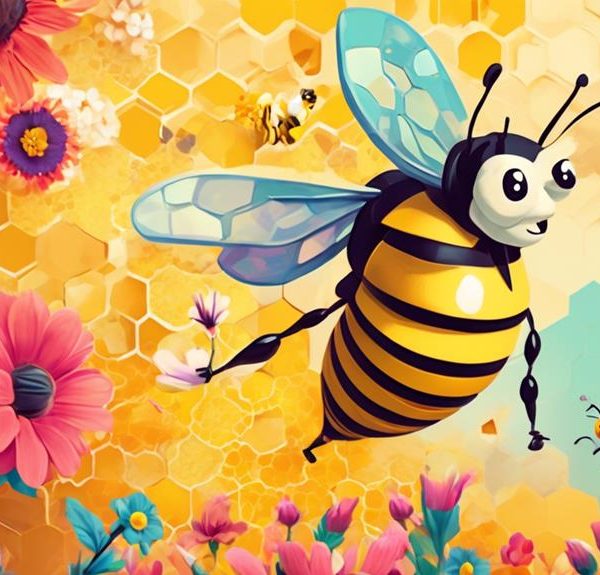Trace the mystery of sudden bee swarms, a fascinating survival instinct deeply rooted in their behavior, in this exploration of insect moving day.
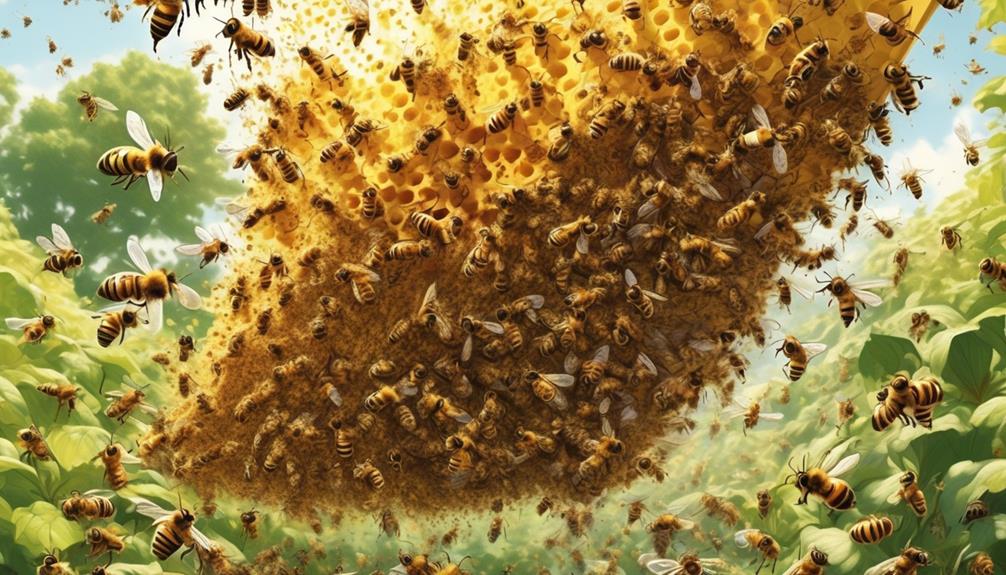
Why Do Bees Swarm All of a Sudden?
Like a sudden, unannounced storm, a swarm of bees can appear out of nowhere, blanketing the sky and causing a fair bit of alarm. You've probably wondered why this happens, why these industrious insects suddenly decide to uproot and descend en masse upon a new location.
It's not random chaos, but a fascinating aspect of bee behavior, deeply ingrained in their survival instincts. As we embark on this exploration, you'll discover the science behind these sudden swarms; the complex, insect version of a moving day.
Stick around – there's a world buzzing with intrigue and mystery waiting to unfold.
Key Takeaways
- Bees swarm as a survival and reproductive strategy for colonies.
- Swarming is a coordinated effort that involves communication through pheromones and dances.
- Environmental changes can trigger swarming in bees.
- Signs such as increased hive population, queen cell development, restless behavior, and unique pheromone production indicate an impending swarm.
Understanding Bee Behavior
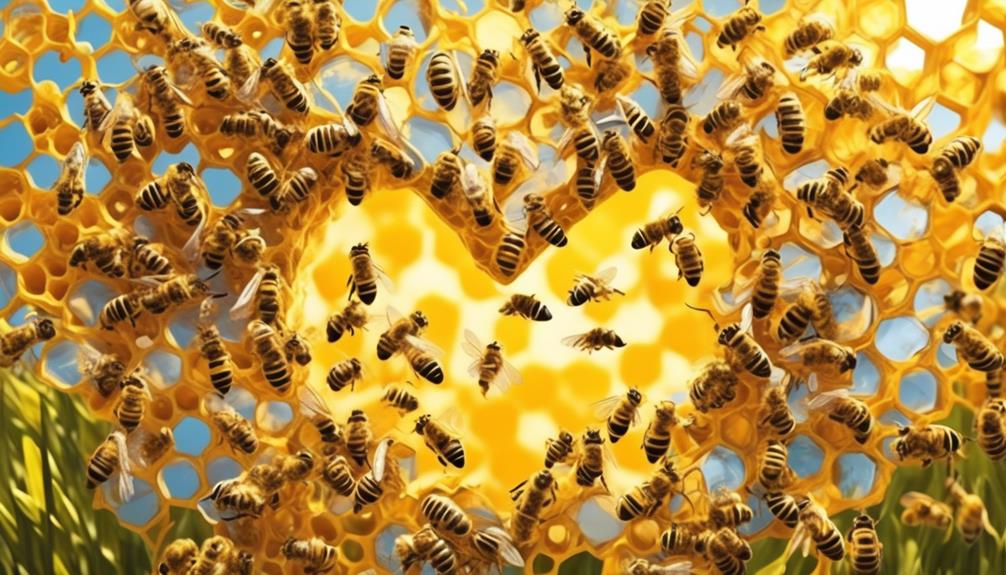
To truly get to grips with sudden bee swarming, you need to delve into the intricate world of bee behavior, understanding their communication methods, social structure, and response to environmental changes.
Bees communicate primarily through the 'waggle dance' – a form of movement that signals the direction and distance of a food source. They're not solitary creatures, but rather, they operate in a highly organized social structure known as a colony, where each bee has a specific role to play.
Crucially, their behavior is heavily influenced by environmental changes. Abnormal weather conditions, lack of food resources, or an overly crowded hive can trigger a swarm. Swarming, in essence, is a survival strategy. When a colony becomes too large, the queen bee sets off with a group of worker bees to establish a new colony, leaving the remaining bees to continue the old colony.
Understanding these aspects of bee behavior is vital in order to respond appropriately to a sudden swarm. If you can predict a swarm, you can take measures to prevent it or at least control its impact. Remember, bees aren't just swarming aimlessly – there's a complex science behind it.
The Science Behind Swarming
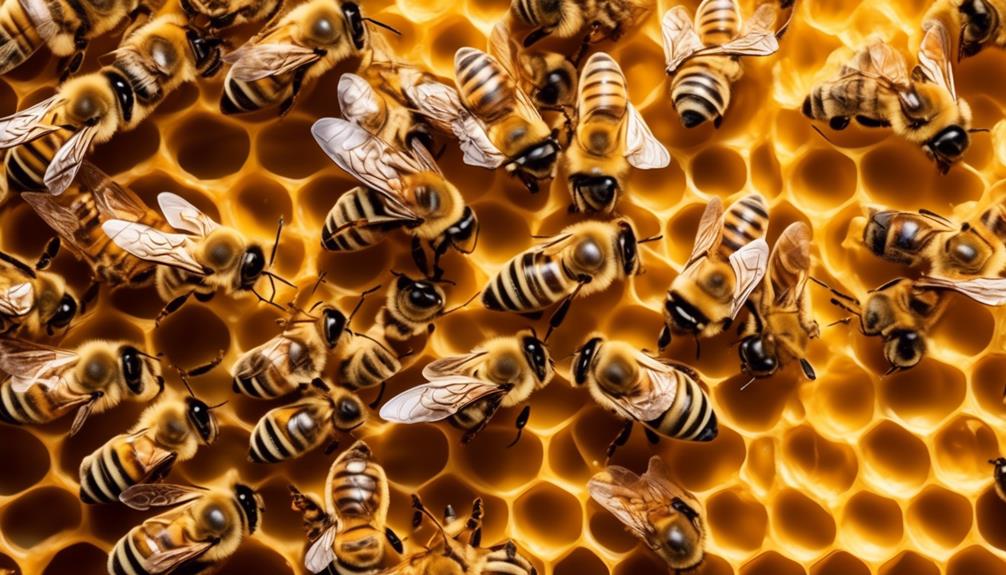
Delving deeper into the science behind swarming, you'll find it's a fascinating process that's steeped in biological imperative and environmental triggers. Swarming is primarily a reproductive strategy. In essence, it's a colony's way of producing new colonies. When a colony becomes too large, a new queen is raised, and the old queen leaves with a portion of the workers to establish a new hive.
Environmental triggers such as changes in temperature or food supply can also instigate swarming. Bees are sensitive to these changes and react accordingly to ensure their survival.
The swarming event is a coordinated effort, not a chaotic flurry. The old queen emits pheromones that the worker bees follow. Scout bees are sent out to find a suitable location for the new hive. Once found, they return to the swarm and communicate the location through a unique dance.
You'll be fascinated to know that this complex behavior isn't governed by a centralized authority but rather by collective intelligence. Each bee contributes to the decision-making process, making swarming a remarkable example of self-organization in nature.
This is the science behind why bees swarm all of a sudden.
Signs of an Impending Swarm

Understanding the science behind the swarming process, it's crucial you're also aware of the signs that a swarm is imminent. It's not as sudden as it may appear; hive behavior offers a range of hints that a swarm is on the horizon.
Firstly, you'll notice a significant increase in the hive's population. The queen bee increases her egg-laying activity, leading to a surge in worker bees. This uptick in bee numbers is a preparatory step for the upcoming swarm.
Secondly, you'll observe the development of queen cells. These peanut-shaped cells, larger than ordinary worker cells, shelter the future queens of the swarm. If you spot these hanging from the bottom of the comb, a swarm is likely imminent.
Lastly, pay attention to the behavior of worker bees. They'll begin to act more restlessly, often hanging around the hive entrance in a 'bearding' behavior. Bees also start producing a unique pheromone to signal an impending swarm.
During the Swarm: What Happens?
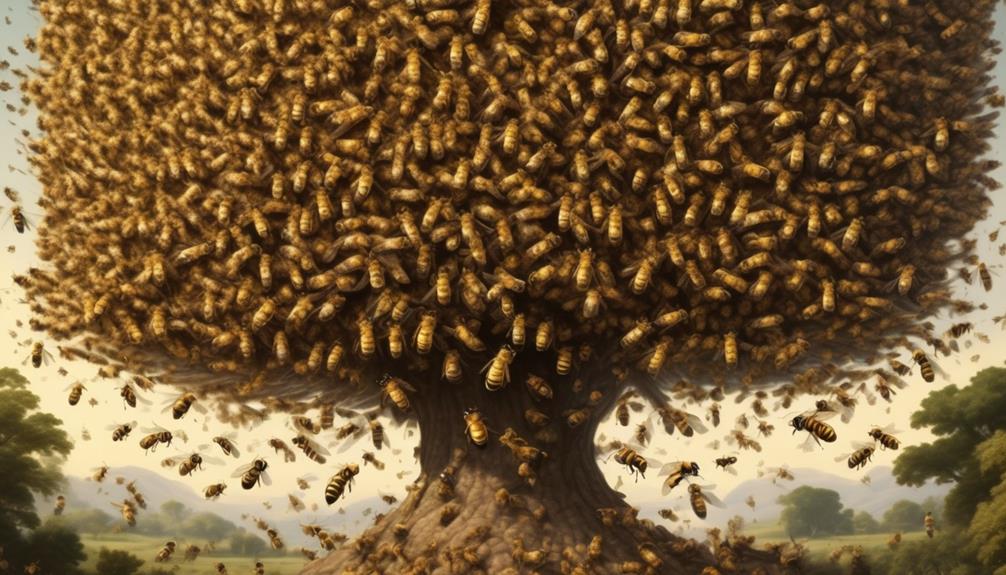
When a swarm occurs, it's a fascinating, complex process that's driven by precise biological mechanisms and intricate bee behaviors. At this point, roughly 60% of the worker bees in a colony will depart with the old queen, leaving the remaining bees and new queen in the original hive.
This exodus isn't spontaneous. It's a planned, strategic move, prompted by overcrowding or lack of resources. Yet, you might be wondering, what happens during the swarm?
The queen bee, typically not a strong flier due to her large abdomen, will fly a short distance and land. The worker bees swarm around her, forming a protective 'bee ball'. This is a temporary state while scout bees search for a new home.
Their search is methodical and rigorous. Scouts inspect potential sites, return, and perform a 'waggle dance' to communicate the location's quality. This dance influences the decision-making process, with the most attractive sites generating the most vigorous dances.
Once consensus is reached, the swarm lifts off, following the scout bees to their new home. This process, while chaotic in appearance, is a testament to the remarkable social structure and communication system that bees have evolved.
The Aftermath: Post-Swarm Activities

After the swarm has relocated, you'll observe fascinating post-swarm activities that are crucial for the survival and growth of the new bee colony.
Worker bees, which constitute the majority of the swarm, begin the labor-intensive process of constructing a new nest. Using wax produced from their own bodies, they construct hexagonal cells, creating the distinctive honeycomb structure. This is a meticulous and organized process; each cell is perfectly symmetrical, maximizing space and efficiency.
Simultaneously, the queen bee starts her vital role in the survival of the colony. She begins laying eggs in the newly constructed cells, a process that can see her producing up to 1,500 eggs per day. This rapid reproduction is essential for increasing the colony's population, ensuring its survival.
Post-swarm foraging activities are also observed. Worker bees venture out in search of nectar and pollen, the primary food sources for the colony. This foraging isn't random but rather a meticulously planned process, with each bee following specific routes to maximize efficiency.
Frequently Asked Questions
What Are the Different Species of Bees That Are Known to Swarm?
You're curious about which bee species are known to swarm. Well, honey bees, including the European and Africanized varieties, are the most notorious for this behavior. But, they're not alone. Bumblebees and some species of wasps can swarm too.
It's important to note, each species has unique motivations for swarming, often linked to their specific life cycles, environmental triggers, and survival strategies.
It's a fascinating aspect of entomology!
How Does the Climate or Weather Affect the Swarming Behavior of Bees?
You're curious about how climate impacts bee swarming. Well, weather plays a significant part.
Bees prefer warm, sunny conditions for swarming. It's typically during spring or early summer, as resources are plentiful for the new colony. Rain, cold, or windy conditions will deter them.
They're sensitive creatures and react quickly to changes in their environment. So, when you notice sudden swarming, consider the weather, it's likely playing a substantial role.
Are There Any Specific Times of the Year When Bees Are More Likely to Swarm?
Yes, there are specific times.
Bees are more likely to swarm in spring and early summer. This is when colonies have the highest population due to an abundance of food sources.
Bees swarm to find a new home because their current hive becomes too crowded. So, you'll notice more swarming when flowers are in full bloom and the weather is warmer, providing ideal conditions for bees to multiply and seek new habitats.
What Measures Can Be Taken to Prevent a Bee Swarm?
To prevent a bee swarm, you've to manage their space wisely. If they're overcrowded, they're more likely to swarm. Regularly checking and managing the hive, providing enough room for the queen to lay eggs, and replacing the queen if she's old, can help.
Don't forget to split the hive if it gets too large. Remember, it's all about maintaining a balance that keeps the bees comfortable and content.
Can Bee Swarms Pose a Threat to Humans or Pets and What Steps Should Be Taken in Such a Situation?
Yes, bee swarms can pose a threat to you and your pets if disturbed. They're often defensive and may sting. If you encounter a swarm, calmly leave the area. Don't swat at them or make sudden movements.
If they've settled in your yard, call a local beekeeper or pest control. They'll safely remove the swarm, protecting both the bees and you.
Conclusion
So, you've seen it all, from understanding bee behavior to the science behind their sudden swarming. You've learned about signs of an impending swarm and what happens during it.
You're now aware of post-swarm activities too. Understanding these complex phenomena helps us appreciate nature's intricate balance.
Remember, bees aren't just buzzing nuisances, they're crucial pollinators. So next time a swarm takes you by surprise, you'll know it's just a part of their fascinating life cycle.


